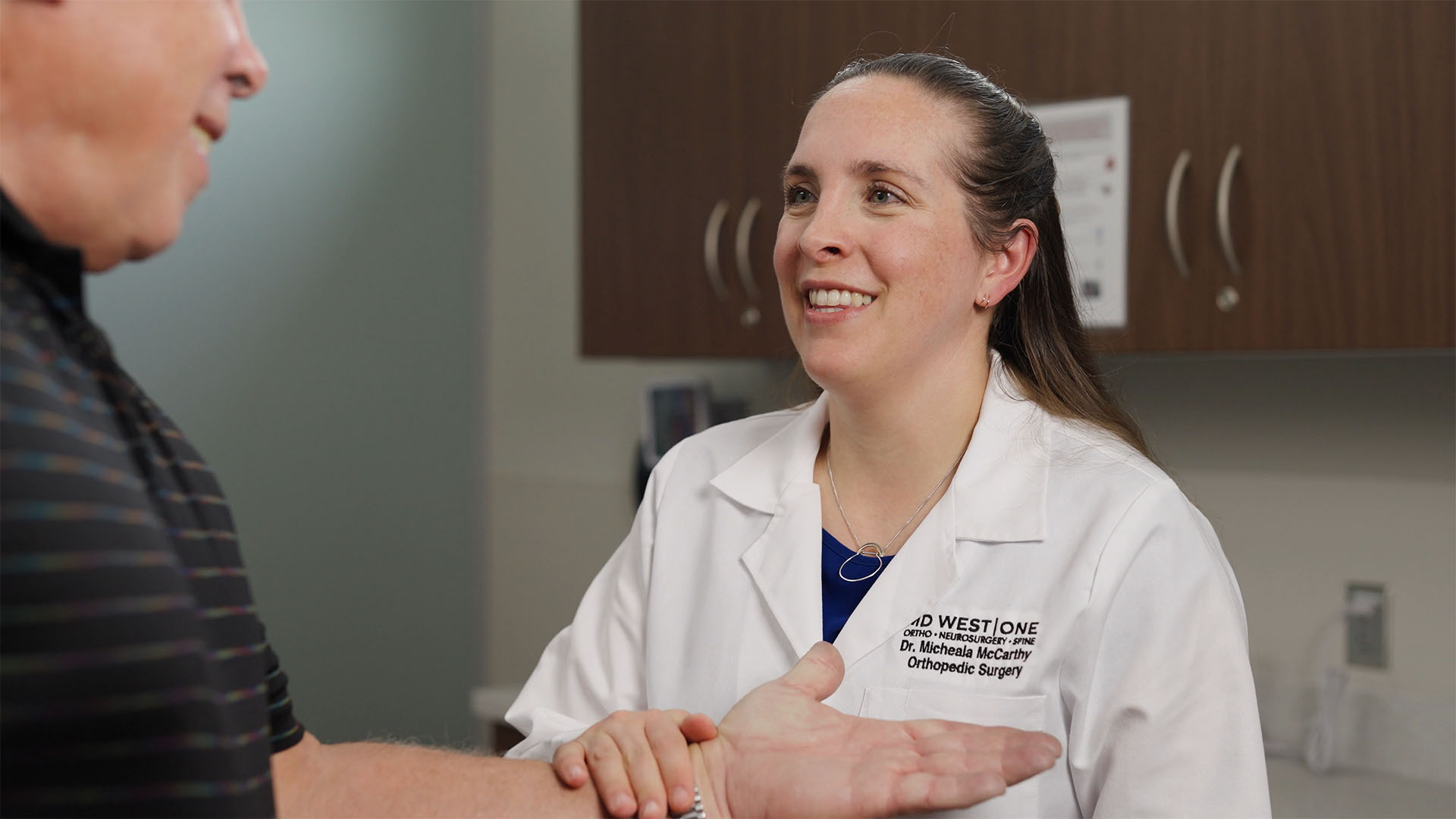Are you suffering from symptoms of Elbow Bursitis?
The Omaha Shoulder & Elbow Specialists at MD West ONE can properly diagnose and treat Elbow Bursitis through non-surgical and surgical treatments. If you have the following symptoms, you may want to make an appointment with one of our Board Certified Specialists.
Symptoms of olecranon bursitis may include:
- Swelling. The first symptom of elbow bursitis is often swelling. The skin on the back of the elbow is loose, which means that a small amount of swelling may not be noticed right away.
- Pain. As the swelling continues, the bursa begins to stretch, which causes pain. The pain often worsens with direct pressure on the elbow or with bending the elbow. The swelling may grow large enough to restrict elbow motion.
- Redness and warm to the touch. If the bursa is infected, the skin becomes red and warm. If the infection is not treated right away, it may spread to other parts of the arm or move into the bloodstream. This can cause serious illness. Occasionally, an infected bursa will open spontaneously and drain pus.
The most common symptom is swelling at the tip of the elbow. Sometimes, people report pain at the back of the elbow and restricted movement or stiffness. Pain is made worse by direct pressure at the back of the elbow.

Meet MD West ONE's orthopedic specialists and learn more about how they treat elbow bursitis

David C. Buck, MD
Sports Medicine & Total Joint

H. Wesley Cheng, M.D.
Sports Medicine & Total Joint

Michael Del Core, MD
Upper Extremity Specialist

George Emodi, M.D.
Sports Medicine & Total Joint

Brett W. Fischer, MD
Sports Medicine & Total Joint

Mark Franco, M.D.
Sports Medicine & Total Joint

Daniel L. Gaffney, MD
Hand & Wrist Specialist

Kayvon Izadi, MD
Hand & Wrist Specialist

Darren Keiser, M.D.
Sports Medicine & Total Joint

Justin Makovicka, M.D.
Knee, Shoulder & Sports Medicine

John "Jack" A. McCarthy, MD
Hand & Wrist Specialist

Micheala McCarthy, MD
Hand & Wrist Specialist

Mark Pitner, MD
Sports Medicine & Total Joint

Charles E. Rosipal, MD
Shoulder & Elbow Specialist

Jeffrey J. Tiedeman, MD
Hand & Wrist Specialist

Kimberly A. Turman, MD
Sports Medicine
Elbow Bursitis: Non-surgical and Surgical Treatment(s)
What is Elbow Bursitis?
Bursa are fluid-filled sacs that cushion bony protrusions like the elbow or knee from damage. Your body has many bursae throughout it. Typically, you do not notice your bursa because it lays flat between your bone and skin.
However, repeated motion can cause your bursa to fill with an abundance of fluid. When this occurs in your elbow, it is known as elbow bursitis. If your olecranon (elbow bone) bursa experiences a lot of irritation or overuse, it may cause the bursa to thicken with fluid. The fluid accumulation may cause the bursa to pucker out, so it sometimes has the nickname "popeye elbow". People experiencing olecranon bursitis may or may not feel pain.
Finding the right physician for your elbow bursitis treatment starts with visiting us.

Are there any non-surgical treatments?
We offer surgical and non-surgical options for olecranon bursitis pain relief.
Many people will find relief with RICE therapy and not using the affected elbow. Icing the affected elbow for 20 minutes a few times a day can help decrease swelling. Wearing a pad over the elbow may reduce the effect of direct pressure on the bursa.
Some non-surgical elbow bursitis treatment options include:
- Activity modification with avoidance of resting on the elbow
- Elbow pads
- The use of over-the-counter anti-inflammatory medication
- Aspiration of fluid to drain bursa and rule out septic bursitis elbow
- Cortisone injection
What if the non-surgical options do not work for me?
For people who need more severe intervention surgical treatment may be needed. While surgery is rare, it is not unheard of to require surgical treatment. Your doctor may recommend surgery if your symptoms have not responded to non-surgical treatment and if medication like antibiotics is not helping.
Surgical removal of your bursa is done as an outpatient procedure. After your surgery, you will need about a month to resume normal activities.
Elbow bursitis is a serious condition that can interfere with your quality of life. Schedule an appointment with our Orthopaedics today to learn more about our innovative approach to elbow bursitis treatment.
